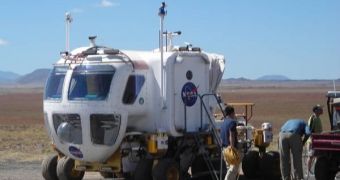In the Arizona desert, NASA recently showcased its latest lunar rover, a vehicle known as the Lunar Electric Rover (LER). Running entirely on electricity provided by batteries and fuel cells, the new instrument has a closed cockpit, which means that astronauts will no longer have to wear their bulky spacesuits, as they explore our natural satellite in the following decade. The machine is driven by 12 pivoting wheels, which enable it to turn around its own axis, and also features a tilting cockpit, allowing space explorers to get a closer view of the ground when needed, Technology Review reports.
The recent drive tests took place in Black Point Lava Flow, Arizona, and the American space agency announced that everything functioned according to plan. The LER, which is the size of a small pick-up truck, proved perfectly able to handle a terrain covered with sand dunes, which are constantly shifted around by sandstorms. The rugged terrain is a close match to the one on the Moon, so the fact that LER proved able to negotiate it raises hopes that it will be able to do so on the lunar surface as well.
NASA's field tests were part of an annual event called the Desert Research and Technology Studies (D-RATS). Astronaut Michael Gernhardt, the NASA Johnson Space Center (JSC) Environmental Physiology Laboratory manager, said recently that the new rover was “close to [fully] operational as possible,” which means that the technologies used on it are not just in prototype form. He also revealed that the rover had an autonomy of 241 kilometers, which means that astronauts could go on long exploration trips without any concerns that their spacesuit batteries or air reserves would run out.
Safety is, however, the primary goal of any exploration mission, so the LER has been designed in such a manner that it can provide shelter for its crew even if it breaks down. And, according to the plans NASA made public, the space agency plans to have two working rovers on the surface of the Moon at all times, so that one rover crew can rescue a stranded one, if the need for that arises. Under the current plans, the agency is to put astronauts back on the satellite by 2020, although that deadline may slip behind schedule by at least one or two years.

 14 DAY TRIAL //
14 DAY TRIAL //